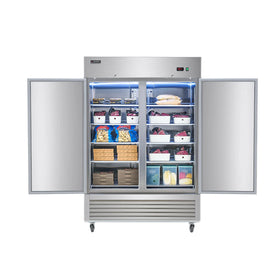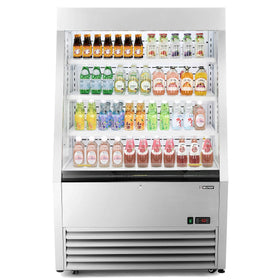If you find yourself with more coconut milk than you need and you are not sure when you will use it next, you can freeze it.
Whether it's from a can or a carton, coconut milk can be frozen, and it will be good for about 1-2 months. The texture might change slightly when you thaw it, but it’s still perfectly usable, especially for cooking, baking, or blending into smoothies.
But there are a few things you’ll want to know bout freezing coconut milk. Most times, it is better to put it in the fridge.
Here is a short guide on how long coconut milk lasts, both in the fridge and the freezer.
How to Freeze Coconut Milk
If you take it out of the can and freeze it in an ice cube tray, your coconut milk can last up to 2 months in the freezer.
Pay attention to these steps when freezing coconut milk:
- Don’t Freeze in the Can: Metal cans aren’t freezer-friendly. They can swell, rupture, or just make a mess.
- Do Transfer First: Pour the coconut milk into an airtight plastic container or a freezer bag. To make it easier to control the portions, freeze it in an ice cube tray so you can measure out exactly 2 tablespoons per cube for precise servings.
- Leave Room: Coconut milk expands as it freezes, so leave a little space at the top if you’re using a container.
Your coconut milk should hold up in the freezer for about 1 to 2 months. After that, it’s still safe, but the quality starts to dip, mainly in texture, not flavor.
Is Frozen Coconut Milk Still Good?
Once thawed, coconut milk may separate—you’ll see the fat floating on top of the watery part. It’s normal, and you can fix it with a quick whisk or a few seconds in the blender. The texture might be a little grainier than fresh, but for most recipes, it won’t be a deal-breaker.
One great tip from my test kitchen experience: When thawing bulk frozen coconut milk, I always give it a quick buzz with an immersion blender to bring it back to a smooth, creamy consistency.
It helps reblend the milk after it separates in the freezing process.
Can You Freeze Canned Coconut Milk?
If you've opened a can and didn’t use it all, freezing the leftovers is a great way to avoid waste. However, do not freeze it in the can. Here’s how to freeze canned coconut milk:
- Transfer it out of the can into a freezer-safe container
- Label it with the date (because let’s be honest, you don’t want to confuse it with something else)
- Use it within a couple of months for the best quality
I’ve found that freezing in ice cube trays works wonderfully—then you can transfer the cubes into a freezer bag once they’re frozen. This way, you can use just the right amount when you need it.
Freezing Coconut Milk-Based Soup?
You can also put your coconut milk soup in the freezer, and it will be fine. Whether it’s a Thai coconut curry soup or a creamy vegan chowder, freezing is fine.
However, just keep in mind that:
- The coconut milk in the soup may separate a bit once thawed.
- A good stir—or blending—usually brings it back together.
- The texture might change slightly, but flavor-wise, you’re still golden.
Coconut Milk in the Fridge: How Long Does It Last?
Let’s talk fridge life—because not everyone wants to freeze right away. How long coconut milk lasts in the fridge depends on whether it is opened or unopened and the kind of carton it comes in. Unopened coconut milk in shelf-stable cartons lasts the longest in the fridge: up to 1 or 2 years.
Here’s a summary of how long you can expect coconut milk to last in the fridge:
Unopened Coconut Milk
- Shelf-Stable Cartons or Cans: These can last 1 to 2 years past the printed date, as long as they’re stored in a cool, dry place.
- Refrigerated Cartons: These have a shorter shelf life and should be kept cold. Check the "use by" date, and don’t push it too far.
After Opening
Once opened, whether it’s from a can or carton, coconut milk should be used within 7 to 10 days. The thicker it is, the longer it won’t spoil, but it’ll only stay good for like a week.
- If your coconut milk has been opened for more than a week, the best option is to throw it out.
- Store it in a sealed container in the fridge. A glass jar or a tightly sealed plastic container works well.
What if you don’t use it up in time? You guessed it—freeze it.
How to Know If Your Coconut Milk is Bad
- A sour or off-smell. If it starts to smell sour, rancid, or fermented, it is a clear sign that it has spoiled.
- If it’s beyond the usual separation (with clear signs of mold or discoloration between the layers), that could indicate spoilage.
- If the coconut milk has clumpy, curdled bits that can't be re-blended or whisked smooth, it might be past its prime.
- If you notice a yellowish, brownish, or greenish tint, it could be a sign that it’s gone bad or is starting to ferment.
- If there are any signs of mold on the surface or around the edges of the container, it's time to toss it out.
- If it passes the visual and smell checks but still tastes off, sour, or bitter, it's best to discard it. Even small amounts of spoilage can ruin a dish.
If you're ever unsure, it’s safer to discard the coconut milk than risk using it and ruining your dish.
Also, if you notice any of these signs before the expiration date, it could be a sign that it wasn’t stored properly or that it had been opened too long.
Store Your Coconut Milk in an ETL-Certified Refrigerator
Reach-in commercial refrigerators and under-counter fridges are best for freezing coconut milk. Here’s what to look for, especially when you're preserving large amounts of coconut milk for regular use in a test kitchen or culinary business.
- A fridge that holds steady just above freezing (ideally around 33°F to 38°F).
- For a freezer, you need -10°F or lower, or even blast chillers if you’re working with hot batches from prep.
- Glass doors, or at least good LED interior lighting, and space to label containers.
- If you're storing coconut milk in containers or ice cube trays, you need wide, deep shelves with customizable heights that accommodate different shapes and sizes.
- If you’re freezing it in portioned trays, clearance for stacking trays or using bins is key.
Recommended Commercial Refrigerators and Freezers
You might also want to explore more commercial reach-in refrigerators.
Final Tips for Freezing Coconut Milk
- Give It a Shake or Blend: After freezing and thawing, always stir or blend coconut milk to bring it back to a smooth consistency.
- Use Thawed Milk in Cooking: It’s best used in recipes where texture isn’t the star, like curries, soups, or baked goods.
- Signs of Spoilage: If it smells sour, curdles, has mold, or changes color, toss it.
- Label Carefully: If you’re freezing coconut milk for later, label your containers clearly with the date. This helps keep track of your frozen inventory.
Wrapping It Up
Remember, it might not be quite as silky after thawing, but frozen coconut milk still brings that creamy, tropical richness to your dishes when you need it.
Do you have a half-can in your fridge right now? Toss it in the freezer—and thank yourself later. And if you’re cooking for one, ice cube trays are your best friend for portion control.
Bonus: They’re also great for storing small batches of coconut milk to use straight in Thai curries.
You Might Be Interested:
We have more useful tips on how to freeze hummus and a detailed guide on determining how much power your refrigerator uses. We also have a superb assortment of commercial kitchen equipment you might need for maximum efficiency in your kitchen.










